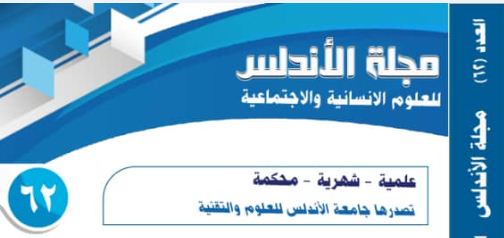A revival evaluation study to drastic to the drastic of the Arabic Language
Main Article Content
Abstract
It is confronting and resisting the tyranny of those who say that Arabic is on the path of the Greek language or other languages. Some contemporary studies have indicated different visions about the Arabic language, its origins, and the foundations of speech in it.
However, Arabic linguistics was able to restore the rooting discourses of the Arabic language and stand up to the baseless accusations made by others. There is an opinion that there is a hidden transition from the Greek language to the linguistics and terminology of the Arabic language, which was later derived by the traditional Arab scholars who began to describe their language scientifically.
This view is rejected by some Muslim scholars who believe that the
265
265
دراسة تقويمية نهضوية لتأصيل جذرية اللغة العربية.
د. زينه حسين عوضه القحطاني
مجلة الأندلس
للعلوم الإنسانية والاجتماعية
العدد ) 62 ( المجلد ) 9( نوفمبر 2022 م
ISSN : 2410-1818
purity of Arabic linguistics, such as the theory of Arabic grammar, is utterly devoid of any foreign influence. Therefore, this research aimed to discover the origin of the Arabic language before the dawn of Islam. As an academic researcher, we will prove that the corruption of the saying that Arabic is influenced by Greek or other, based on clear proof against the idea that Arabic is after Greek, but rather the opposite is true. This research focuses on developing body language to make a balanced judgment.
Parts of the research: The research included an introduction, a preface, two chapters, a conclusion and indexes, and its details are as follows:
• Introduction: It included the importance of choosing the research, the reasons for choosing it, stating its problem, its objectives, and mentioning previous studies, with an explanation of the research writing methodology.
• Preamble: The definition included a review of the material that the Arab linguists kept for us and a treatment of the difficulties that were closely related to Classical Arabic, but since ancient times, its developments have taken directions that differ from the developments of Standard Arabic, meaning that it represents a language other than Arabic in some structures and semantic meanings.
• The first topic: the origins of the Semitic languages, the interpretation of the developments that developed from the first language and the disclosure of its developments
• The second topic: writing activities in the ancient Near East, following the term "radical" instead of Semitic.
• Conclusion: It is concluded by mentioning the ancient civilization that indicates the existence of several evidences through antiquity based on the first manuscripts written by primitive peoples, and an indication of the existence of manuscripts that date four hundred years before BC, written inSumerian script, as some orientalists claim that they came from civilization Sumerian.
Method in the research: This study will follow the ancient Semitic languages and this study has followed two approaches: the descriptive approach, which describes the study and its developments since ancient times, and the analytical approach, which is concerned with analyzing the most important vocabulary that has a linguistic root.
• The most prominent findings and recommendations:
This study will present the most prominent results of Semitic languages and their relationship to the Standard Arabic language, in a set of points, the most important of which are the following: 1- To mention historical sources and human studies, especially studies that highlight the relationship of Classical with Semitic languages, and its
266
266
دراسة تقويمية نهضوية لتأصيل جذرية اللغة العربية.
د. زينه حسين عوضه القحطاني
مجلة الأندلس
للعلوم الإنسانية والاجتماعية
العدد ) 62 ( المجلد ) 9( نوفمبر 2022 م
ISSN : 2410-1818
relationship to historical traceability of ancient inscriptions.
2- That the anthropological studies complete the linguistic migrations in the linguistic displacements that migrated to the Fertile Crescent and, with the succession of generations, became the nations of the Babylonians, Phoenicians and Hebrews.
• Paying attention to inscriptions that were concerned with collecting ancient scripts from antiquities and inscriptions after archaeological discoveries of therelationship to historical traceability of ancient inscriptions.
2- That the anthropological studies complete the linguistic migrations in the linguistic displacements that migrated to the Fertile Crescent and, with the succession of generations, became the nations of the Babylonians, Phoenicians and Hebrews.
• Paying attention to inscriptions that were concerned with collecting ancient scripts from antiquities and inscriptions after archaeological discoveries of the ancient languages of the Arabian Peninsula, the Levant, Egypt, Iraq, Lebanon, and the Yemeni language and its dialects (Mainite, Sabaean, Qataban, Hadrami, Ousani, and Hamya).
Keywords:
Arabic linguistics, the Arabic language, the origin of the Arabic and Semitic languages.

